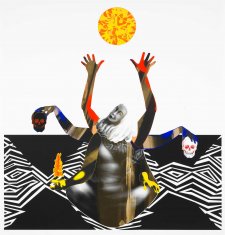Artist Howard Arkley and musician and writer Nick Cave AO (b. 1957) moved in the same creative circles in Melbourne in the 1970s. Cave formed his first band, eventually named The Boys Next Door, when he was a student. After leaving school the band became embedded in Melbourne’s post-punk and alternative music scenes, renaming themselves The Birthday Party when they relocated to London. Based on photos, posters and clippings, this portrait was made in Arkley’s Melbourne studio in 1999, when Cave was the frontman for Nick Cave and The Bad Seeds. The result is a portrait that evokes the material culture of the underground music scene, as well as the emotional intensity of Cave’s writing and music. Its pulsating colour coveys the noise and lurid stage lighting of the venues where Cave made his start. It is an unmistakeable example of Arkley’s work and a distillation of the many stylistic and technical threads that run through it – from the abstract compositions of his early career to the airbrush paintings of suburban homes and interiors for which he is best known.
Commissioned with funds provided by L Gordon Darling AC CMG 1999
© Estate of Howard Arkley. Licensed by Kalli Rolfe Contemporary Art.
A portrait of the musician, Nick Cave, by Howard Arkley, created in 1999. Acrylic paint on stretched canvas, unframed, measuring 175cm high and 135cm wide.
The image undulates with flowing lines that define the contours of his face, creating organic shapes. It is painted in clashing colours that pulse alongside one another, creating a fluid yet graphic quality. The edges of these shapes are hazy having been outlined with an airbrush. The background is revealed in the lower left corner and is painted a matt teal.
His face fills the canvas and is cropped at the neck. His head is turned towards us with his left ear visible, the right ear remaining out of view.
His hair, cut off by the edge of the painting is disheveled and wavy. The tendrils of hair are reminiscent of seaweed and painted in thick locks of different shades of blue and purple, outlined in deep indigo. It tumbles down surrounding his long face, tucked behind his left ear and curling at the ends to rest around his neck.
The shape of his face is described in five solid colours that are painted in a combination of competing cool and warm tones. His forehead and cheekbone are the highest points, painted white, with the lower planes of his face shaded in purple and a deep fuchsia with peach and neon yellow in between. His left ear is painted in the same manner, highlighted in pops of the same colours.
Deep-set eyes are shadowed in purple and fuchsia, exaggerating and defining the eye sockets. A crescent stroke of deep blue is painted beneath both eyes. The exception to the indistinct airbrushed lines is a source of light reflected in the iris of both eyes, detailed by sharp edged white marks. These hard edges draw attention, enhancing the intensity of his aloof gaze that conflicts with the brightness of the painting.
His nose sweeps down from his right eye in curling lines and shapes of peach, white and pink. A shadow beneath his nose connects to his top lip. His mouth is closed in a resting position with pouty pink lips.
His curved jawline casts a shadow onto his creamy white neck. The contrast of his stark neck against his vivid face give the impression he is wearing a mask, adding a sense of theatre and glamour to the work.
Audio description written by Alana Sivell and voiced by Emma Bedford
The Gordon Darling Foundation (36 portraits supported)



On one level The Companion talks about the most famous and frontline Australians, but on another it tells us about ourselves.



Joanna Gilmour reflects on 25 years of collecting at the National Portrait Gallery.



Gallery directors Karen Quinlan and Tony Ellwood talk to Penelope Grist about the NPG and NGV collaborative exhibition, Who Are You: Australian Portraiture.